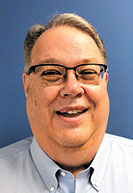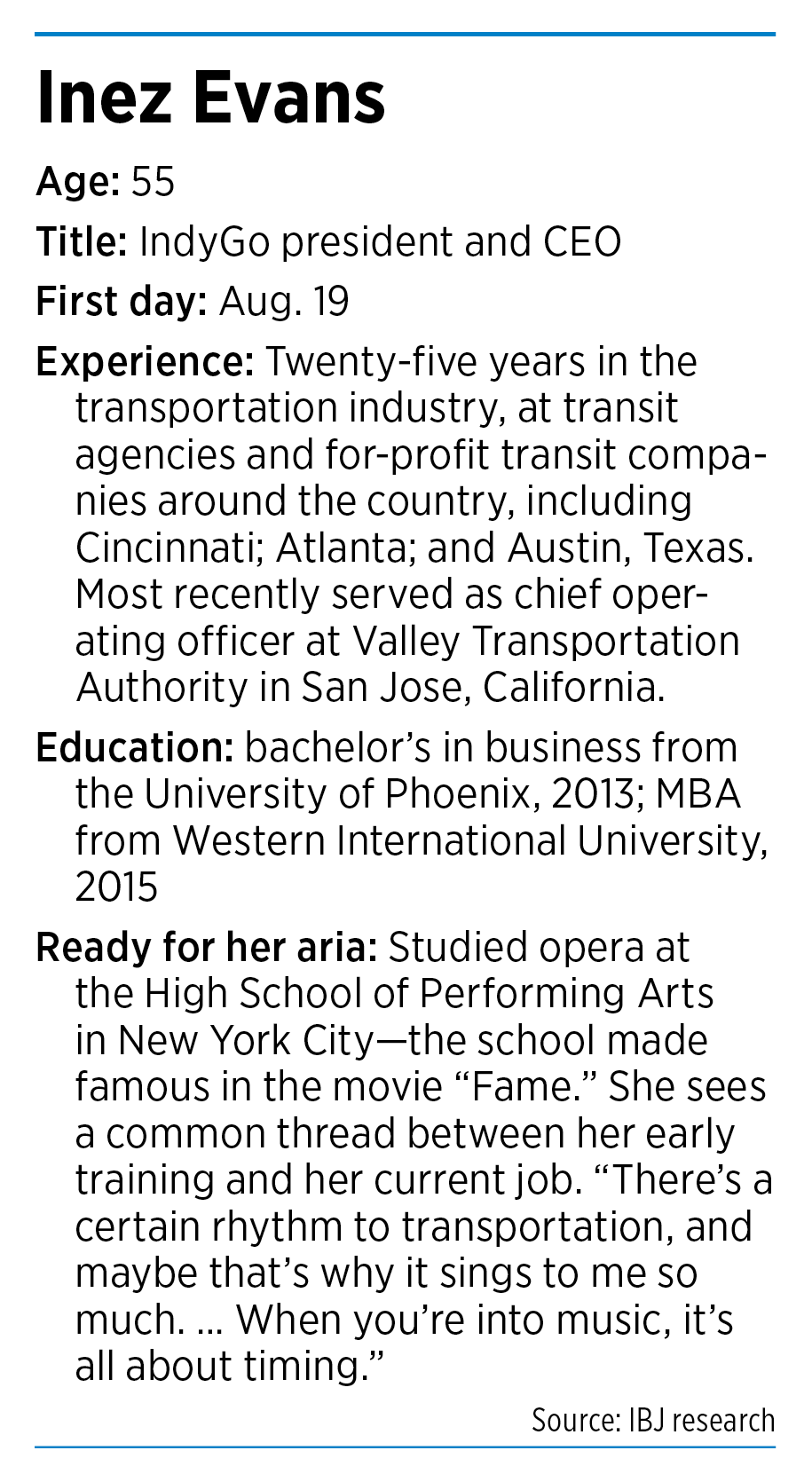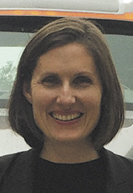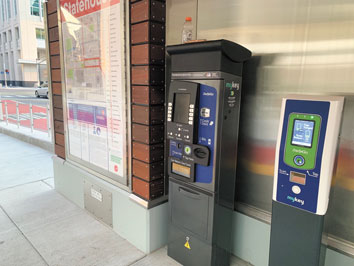Subscriber Benefit
As a subscriber you can listen to articles at work, in the car, or while you work out. Subscribe NowWith the launch of the Red Line and a host of other service improvements, IndyGo’s next task is to persuade riders to climb aboard.
The transit system is in the early stages of a plan to gather data on the employers and schools along its bus lines and develop specific pitches to persuade their employees or students to ride—and maybe cajole the employers to subsidize the cost.
That’s not a new concept among transit agencies, but it is new here. That, IndyGo officials admit, is because until now, its bus service has not been strong enough to appeal to those with other options.
“I think, if you look over our history, there’s not been a tremendous investment in transportation,” said IndyGo’s new president and CEO, Inez Evans. “And so, folks have had to depend on that car because there was no other option. And now that we’re investing in transportation here, we believe that we’re truly going to give others a viable option.”

 Last year, IndyGo partnered with Indianapolis Public Schools to offer free IndyGo rides to students at Shortridge and Arsenal Tech high schools, a pilot program that expanded to all IPS high schools this year. IndyGo also has partnerships with Purdue Polytechnic and Indianapolis Metropolitan high schools.
Last year, IndyGo partnered with Indianapolis Public Schools to offer free IndyGo rides to students at Shortridge and Arsenal Tech high schools, a pilot program that expanded to all IPS high schools this year. IndyGo also has partnerships with Purdue Polytechnic and Indianapolis Metropolitan high schools.
Now, IndyGo is looking to form additional partnerships with colleges and employers along all its bus routes, with a special focus on the downtown area.
“We just recently met with one employer and we’ve asked for their GIS data—the ZIP codes of where their employees live—so we can begin to look at additional strategies on how we can get some of their cars” off the road, Evans said.
Evans declined to identify the employer. But, she said, once IndyGo has that data, it can determine how many employees live near bus stops—and thus might be willing to give IndyGo a try.
In talking with employers, Evans said, IndyGo might also discover obstacles it needs to address. If, for instance, an employer needs its employees to be at work at a specific time, IndyGo might be willing to adjust its schedule on certain routes to meet that need.
IndyGo also envisions conversations that would reveal reasons why people don’t ride the bus, and what might persuade them to start, Evans said. “Working with the employers to do surveys with their employees to find out, what would be that pivot point—or what is that impediment? We need to gather more data.”
Evans said IndyGo hasn’t set any specific goals for how many partnerships it might form through its marketing effort, or how ridership might increase as a result. But Evans’ former employer, the Valley Transportation Authority in Santa Clara, California, saw good results with a recent marketing campaign of its own.

Evans was chief operating officer at VTA from 2015 until last month, when she left that job to join IndyGo.
In May 2017, the VTA launched its first bus rapid transit line, which spans just more than 7 miles and connects downtown San Jose with East San Jose.
To promote the service to potential riders, the transit system did a radio, print and social media campaign, including digital marketing that geo-targeted potential riders within a quarter-mile of the route, said VTA spokeswoman Brandi Childress.
The campaign also targeted those who might use the bus at different times of day: service workers with early or late work schedules, young adults going out to bars and restaurants and senior citizens taking day trips.
VTA conducted a similar campaign in January 2018 when it improved the frequency and hours of service on the BRT line.
“With a continuous marketing effort the results have been significant in ridership increases,” Childress told IBJ via email.
In February 2018, the system saw a 26.4% year-over-year ridership increase on the route. More than a year after the bus rapid transit system’s launch, the system still saw increases, Childress said. Ridership increased 5.1% between August 2017 and August 2018, and it increased 10% between September 2017 and September 2018.
Targeted marketing campaigns are key to attracting new ridership, said transit consultant Jim Moore, a managing partner at Valencia, California-based Moore & Associates Inc. “It should be a core strategy for any transit provider.”
And going after schools and employers, as IndyGo plans to do, Moore said, is a strategic way to increase consistent ridership. “Those are the type of people we want to attract,” he said of students and employees. They’re making the same trip again and again. They’re reliable.”
Targeting Cummins

Cummins Inc. is one of the entities IndyGo is eyeing as a potential transit partner. The Columbus-based engine maker’s Indianapolis office sits across the street from IndyGo’s downtown transit center, which is at the corner of Washington and Delaware streets.
Cummins spokeswoman Katie Zarich said the company offers free parking at its on-site parking garage, and it also offers indoor bike racks and a shower facility for employees who bike to work.
The company doesn’t offer subsidies for IndyGo riders, Zarich said, but some Cummins employees have taken notice of the recently launched Red Line and other system improvements. “There’s been a lot of conversation about it, people talking about it.”
An internal employee group at Cummins invited IndyGo to deliver a “lunch and learn” program about the Red Line late last month, Zarich said, and organized a progressive dinner during which employees rode the Red Line between restaurants in Fountain Square and Broad Ripple.
When it comes to daily commuting, Zarich said, Cummins’ Indianapolis employees do have some special needs. It’s not uncommon, for instance, for employees to have meetings in both Indianapolis and Columbus on the same day. “We work out of different locations on a regular basis,” she said.
That’s why some employees drive their cars, Zarich said, but Cummins also offers a daily shuttle service between Indianapolis and Columbus for a small fee.
Car culture

Why do transit systems need to market themselves at all? Experts say it’s because even when transit systems dramatically improve their service, riders won’t automatically swap their car keys for a bus pass.
Every transit system serves riders who must rely on transit because they don’t drive or don’t own a car. But attracting riders who have other options is more difficult.
“In public transit, our competition is always the personal vehicle,” Moore said. “We often just become very engrained to a traditional travel pattern to take our trip.”
That’s true even for younger people, who as a group are more inclined to consider transit, said Art Guzzetti, vice president of mobility initiatives and public policy at the American Public Transportation Association.
“We’re finding, through our research, that new generations are open to public transit in ways that are different than before—but that doesn’t mean they’re automatically going to be transit riders,” Guzzetti said. “There’s an openness to transit, but it has to be a good choice.”
Part of what makes transit a good choice, of course, is the strength of the service itself. But IndyGo also hopes it can persuade employers to rethink the transportation perks they offer.
Maybe, for instance, IndyGo can persuade employers to offer their workers bus passes, just as they may already offer free parking.
“The parking policies and the benefits that employers offer has a huge impact on whether people will choose transit,” said Bryan Luellen, IndyGo’s vice president of public affairs.
“If companies are still operating under this assumption that employees are just going to drive and they offer them a free parking pass, and transit isn’t even part of the conversation at the corporate level, then that’s really difficult to get somebody to choose to pay for transit versus use the employer-provided parking pass that they have.”•
Please enable JavaScript to view this content.


Great idea and she is definitely thinking outside the box. Hopefully this will result in increased ridership.
This is a common perk in most cities that have dependable, reliable mass transit. Some employers may opt to subsidize parking costs, while others choose to subsidize transit costs. Here, with a daily cost of not more than $3.50 (or $910 per year) the cost to pay for an employee’s use of transit is substantially less that the cost of parking all day in a garage or lot. Employers and employees, who also save on gas, benefit as do taxpayers who help pay for better bus service.
Agreed with Brent’s whole point, though the annual cost isn’t even as high as he stated. New fare capping coming in October will cap daily use at $4 and weekly use at $15.75. Times 52 weeks, the max annual cost of IndyGo usage is $819.
How can they propose to bring in more riders when after 3 weeks, the Red Line is grossly ineffective at meeting schedules and riders have turned away in droves after waiting 90 minutes with no bus coming. Better get the service resolved before coaxing other to try and be disappointed. Article: https://indyimby.com/2019/09/23/red-line-i-love-you-but-youre-bringing-me-down/
Agree completely. I desperately want the Red Line to succeed, but I had to give up and get my car after waiting 30 minutes for a bus on Saturday night. In addition, the electric signboards were incorrect. IndyGo must get these issues worked out before it starts charging people to ride.
It’s not rocket science… but the #1 way to increase ridership is to actually be on time. With anything new, there are going to be learning curves, but this is a simple bus schedule that has been talked about for years. Bloomington and other cities compared to Indianapolis actually have a reliable bus system.
I tried to ride it 3 times. First time, as my group was walking to the bus stop, we see one bus leaving the stop. Obviously, that was OK… but not even one minute later, the next bus stopped and immediately left before we got there. So, then, we had to wait 30-40 minutes for the third bus to arrive… all while the TV screen said “Bus is Here”. Seeing two buses being grouped together like that is a common occurrence.
Second time, we waited at the main downtown bus stop for 10 mins. Excited because the bus actually quickly arrived. A couple minutes after we get on the bus, everyone was told to get off and wait for next bus because that one was going to the garage. After waiting 30+ minutes for the second bus, we hailed an Uber.
Third time, tried to take the Red Line from downtown stop to another downtown stop. We left from work 15 minutes before coworkers who (smartly) decided to drive. Even though the restaurant we went to was less than one block from our ending bus stop, they were seated at the table 20-25 minutes before us.
Fourth time, decided to take an Uber without even going to a bus stop.
I want it to succeed too. But, after dealing with all the construction hassle and paying $100+ million, it’s been a huge disappointment to have this joke of a BRT as a result. The majority of people/businesses preferred having extra lanes and additional parking spots before Red Line construction. The traffic patterns are TERRIBLE compared to what they were pre-construction. There are traffic jams along the route, even during non-rush hour. Drivers are still getting confused from when College, Capitol, Meridian, etc. decrease from 2 or 3/4 lanes to 1 or 2 lanes. Plus, the new bike lanes on Illinois cause an increase in traffic too.
Getting to Broad Ripple from Fall Creek Pkwy & College pre-Red Line construction was a breeze. Now, it’s normally faster to take Fall Creek Pkwy to Keystone. To get downtown from the northside, more drivers are cutting through Delaware Street which I’m sure those residents loathe.
It’d be nice if the city had more park-n-rides near bus stops or additional free parking along the route to incentive people who don’t live within a 1/4 mile of a stop to take it.
At the end of the day, wish we chose an option to improve public transit without going the BRT route.
Massive headache.
People may say I’m overreacting, but this is common feedback from lots of people.
It’ll be interesting to see what the legit ridership numbers are for each month going forward. Although I’m initially frustrated, I hope IndyGo can fix these massive issues.
I used to have a negative view until my son started going to Purdue Polytechnic. Now, I cant say enough good things about it. I’m so glad PPHS is using Indy Go instead of school buses. Isaac has such varied places he goes every day. Ranging from NW Indy, Castleton, Fort Ben and Southport most weeks. It has been such a blessing that he can get to most places in Indy and we don’t have to be the taxi. Isaac reports he hasn’t had many problems. The only problem is it takes so long to get anywhere. But I am very grateful to Indy Go and excited that they are expanding services. It’s definitely worth all the money the city is poring into it. Now you do have to be careful late at night. Especially if you are on the far east side. But, fortunately we haven’t had any problems.
I know it’s far from perfect and that there are some real issues to iron out. But it has been a lifesaver and a big blessing for our family.
One of the reasons the Red Line and the other routes are running late, there is a shortage of drivers. I saw where new drivers are being trained to take those positions. We are having to adjust our driving habits as expected change can be difficult. I really want to see the Red Line succeed for those who don’t have cars or choose not to drive. Prior to all that Indygo is trying to do and has done so far, many I know talking about and trying out the Ref Line.